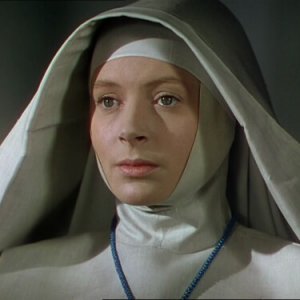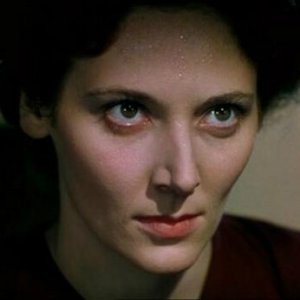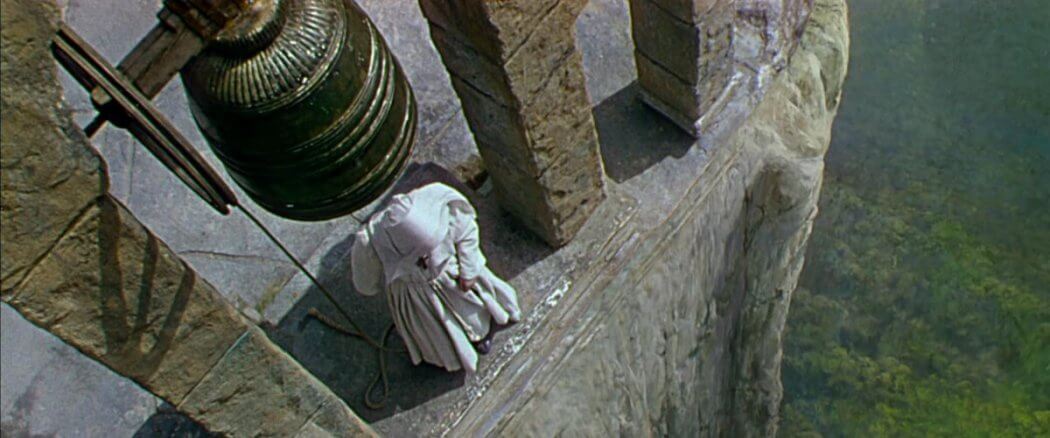Telling someone about a dream is akin to telling them about a physical ailment — no one actually cares — so I’ll keep it short. I had a dream, during the writing of this review; I was sitting with a friend on the high point of a park, overlooking the landscape. “It would be more convincing,” he said, gesturing to the view, “if it was covered in glass.”
Of course I don’t believe the dream was coincidental, not only because Black Narcissus is set in a place of natural beauty, but because the film is filtered through artifice, with man-made materials, mostly in a studio, and because of that, it is, consequently and paradoxically, more and less human — much like the effect of sin.
House of Women
Sister Clodagh (Deborah Kerr), the newly-appointed and youngest Sister Superior of a British order, is charged with opening a school on the peaks of Kanchenjunga, in the palace a previous General constructed to “keep his women.” Four other sisters are sent with her, of varying dispositions and abilities, yet each will find herself haunted by memories and conflicted with desires. But then, memory and desire are nearly always related, as is sublimely demonstrated in one of the film’s most breathtaking moments: an impeccable cross fade from a close-up of Sister Clodagh in flashback to almost the exact same shot in present tense.
 “It’s this place,” Sister Clodagh frets, “with its strange atmosphere and new people.” The new people include Mr. Dean (David Farrar), a charming ruffian who is “not a good man.” Based on dialogue like this and the visual delineation between the order and the village, it’s convenient to conclude which group of people represents the spirit, and which the flesh. But the film’s title is derived from the name of a perfume the young General wears, a perfume not from the area, but from London. Scientists have claimed smell as the sense most powerfully linked with memory. All the British sisters smell Black Narcissus, and following their noses will lead them to different places.
“It’s this place,” Sister Clodagh frets, “with its strange atmosphere and new people.” The new people include Mr. Dean (David Farrar), a charming ruffian who is “not a good man.” Based on dialogue like this and the visual delineation between the order and the village, it’s convenient to conclude which group of people represents the spirit, and which the flesh. But the film’s title is derived from the name of a perfume the young General wears, a perfume not from the area, but from London. Scientists have claimed smell as the sense most powerfully linked with memory. All the British sisters smell Black Narcissus, and following their noses will lead them to different places.
The Message About Color
“I had worked on Thief of Baghdad and I got the message about color…” Director Michael Powell recalls on the commentary. “In Hollywood they hadn’t quite realized we had lots of painters — people who knew that red was different than green — and nearly all my art department staff were painters, and so automatically we didn’t need so many Technicolor technicians telling us what we knew already.”
This artistic sensibility is palpable, and draws comparisons from Vermeer to Disney; the latter is impossible to see until mentioned, when it becomes impossible not to see. Sometimes the approach is obvious — nearly all the landscape backdrops are gorgeous original paintings — and other times it is subtle – how light gathers on a puddle at the bottom of the frame. Yes, color is light and light is color, but the color and light of Black Narcissus seem to blend and transcend in a way that’s still astounding.
The entire team deserves credit, but Jack Cardiff gets extra credit, a legendary cameraman who, when not in the studio, was in the studio, painting in the style of famous artists. With Cardiff, “color itself became the emotion of [Black Narcissus],” Martin Scorsese gushes. And in an English melodrama, there is no shortage of emotion.
Worst of All Sinners
“Don’t you think you’re letting things run away with you? I think you have let yourself fall into thinking too much of Mr. Dean,” Sister Clodagh reprimands, grasping a pencil and meeting the glare of Sister Ruth (Kathleen Byron). “All the same,” Sister Ruth retorts, “I notice you’re very pleased to see him yourself.”
 It’s a riveting moment, not only because of the camerawork and performances, but because it articulates the difference and similarity between Sisters Ruth and Clodagh; that regardless how we strive to split the flesh from the spirit, or submit the former to the latter, or integrate them, it is not wholly possible.
It’s a riveting moment, not only because of the camerawork and performances, but because it articulates the difference and similarity between Sisters Ruth and Clodagh; that regardless how we strive to split the flesh from the spirit, or submit the former to the latter, or integrate them, it is not wholly possible.
As the Sisters’ desires compare and compete, good and evil are represented by one, then the other. Even when, for the sake of the story, they seem to be settling into the expectations of protagonist and antagonist, Sister Ruth removes the habit to reveal her hair, styled and colored identically as the flashbacks of Sister Clodagh, as if the film is insisting they are one and the same: the worst of all sinners.
The Seeds of Defeat
Michael Walker intuits that all the Sisters “carry within themselves the seeds of their own defeat.”* And each of them keeps piling on the dirt, trying to bury it — except for Sister Ruth, in an uprising we could predict upon first meeting her; perhaps because, in the words of actor Kathleen Byron, “[Jack Cardiff] gave me half of my performance, with the lighting.”
You could replace lighting with script, direction, music, art direction. Everything in the film is the other half of everything else, which is not how fractions work, or how marriages work, and yet those are the only metaphors working for me. Each cinematic element is whole and a fraction, completing the others in a holy union of one flesh.
Too early in the film, Powell remarks that Sister Clodagh is “doing her best to fall in love with Jesus.” While there is a fall in the film, it’s not in love, and not until the end. However, it’s just possible that, through it all, Sister Clodagh has realized her humanity. And that is the beginning of holiness.
*From Framework 9, Winter 1978/79





